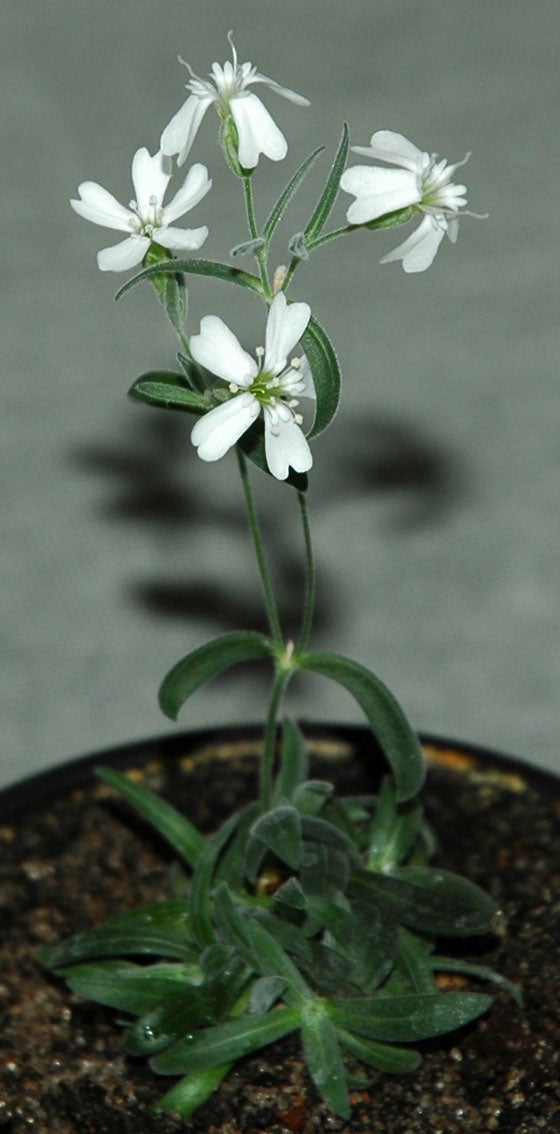Russian Scientists Grow Pleistocene-Era Plants From Seeds Buried By Squirrels 30,000 Years Ago
On the frozen edge of the Kolyma River in northeastern Siberia, in an ancient pantry harboring seeds and other stores,...

On the frozen edge of the Kolyma River in northeastern Siberia, in an ancient pantry harboring seeds and other stores, an Arctic ground squirrel burrowed into the dirt and buried a small, dark fruit from a flowering plant. The squirrel’s prize quickly froze in the cold ground and was preserved in permafrost, waiting to grow into a fully fledged flowering plant until it was unearthed again. After 30,000 years, it finally was. Scientists in Russia have now regenerated this Pleistocene plant, transplanting it into a pot in the lab. A year later, it grew forth and bore fruit.
The specimen is distinctly different from the modern-day version of Silene stenophylla, or narrow-leafed Campion. It suggests that the permafrost is a potential new source of ancient gene pools long believed to be extinct, scientists said.
The fruits were buried about 125 feet in undisturbed, never thawed permafrost sediments, nestled at roughly 19.4 degrees F (-7 C). Radiocarbon dating showed the fruits were 31,800 years old, give or take about 300 years. Seeds are incredible things, storing the embryo of a new plant and encasing it in protective material until conditions are right for it to germinate.
Scientists led by David Gilichinsky at the Russian Academy of Sciences worked with three of these fruits and took placental tissue samples. They fed the tissue cultures a cocktail of nutrients to induce root growth, and once the plants were rooted, they were transplanted into pots in a greenhouse. Just as they were supposed to, plants grew, developed flowers and fruits, and went to seed. (Gilichinksy died a few days ago, the BBC reported.)
Gilichinsky and colleagues also grew modern-day narrow-leafed Campion as a control, and noticed some key differences among the two generations — the Pleistocene version put out twice as many buds, but the modern version put out roots faster.
To ensure the ancient plants’ own new seeds were viable, the team artificially pollinated the flowers and germinated the resulting seeds. Get this: The seeds from the ancient plants fared even better than the modern ones. The regenerated ancient plants had a 100 percent germination rate, while the control plants had an 86 to 90 percent rate. The research suggests that old age and ice would not have prevent these plants from flowering again someday — if anything, it would be the radioactive cycle of the planet itself. Like anything on Earth, the plants were exposed to low levels of gamma radiation from the radioactive decay of elements in the crust. Over 30,000 years, that adds up to a fair amount of gamma radiation. The scientists calculated that the fruits got a dose of 0.07 kGy of gamma radiation, and they say this is now the maximal dose after which tissues will remain viable and seeds will still germinate. If someone finds a plant older than 30,000 years, maybe that number will go up.
All of this is interesting not just because it’s amazing to regenerate a Pleistocene plant, which of course it is, but because the permafrost may be an important new gene pool. Other ancient squirrel burrows have been found in the Yukon territory and in Alaska. That’s interesting for pure research, but also because of what may happen as the planet warms and more permafrost regions thaw. Organisms will be released from their long, cold sleep, and these ancient life forms could become part of modern ecosystems, affecting modern phenotypes and changing the landscape.
“We consider it essential to continue permafrost studies in
search of an ancient genetic pool, that of preexisting life, which hypothetically has long since vanished from the Earth’s surface,” the authors write.
The paper was published this week in the Proceedings of the National Academy of Sciences.
[via BBC]